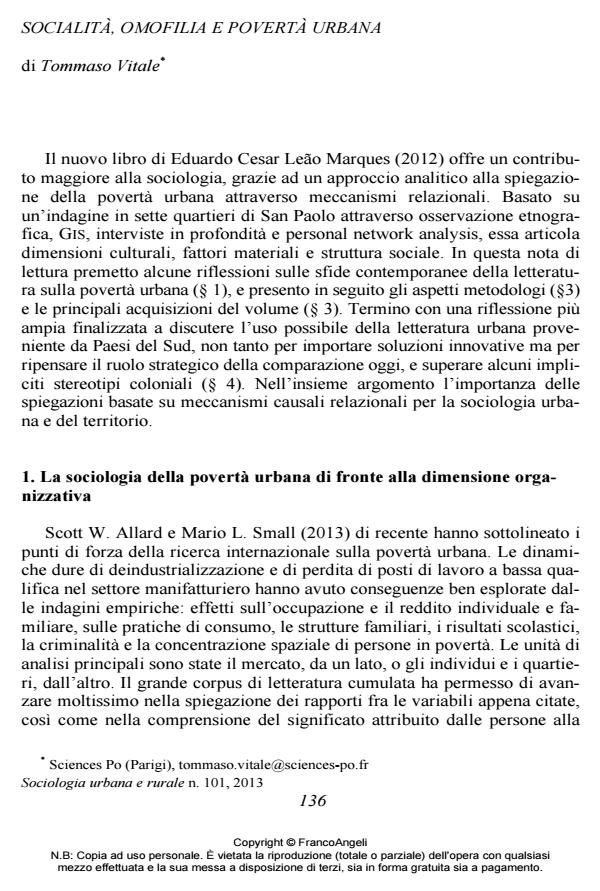Sociability, Homophily and Urban Inequalities
Journal title SOCIOLOGIA URBANA E RURALE
Author/s Tommaso Vitale
Publishing Year 2013 Issue 2013/101
Language Italian Pages 13 P. 136-148 File size 239 KB
DOI 10.3280/SUR2013-101011
DOI is like a bar code for intellectual property: to have more infomation
click here
Below, you can see the article first page
If you want to buy this article in PDF format, you can do it, following the instructions to buy download credits

FrancoAngeli is member of Publishers International Linking Association, Inc (PILA), a not-for-profit association which run the CrossRef service enabling links to and from online scholarly content.
Current debates on urban poverty raise two main research questions, on the role of organizations and social services on enlarging social capital, as well as on the effects of segregation on personal networks of the poor. The book of Eduardo Marques (2012) on Sao Paulo analyses 239 personal networks to answer to these questions. It shows that the relation between spatial segregation and personal network is not linear, and that personal networks of the poor can vary, with different extension and many type of sphere of sociability. Networks characterised by strong homophily and higher localism, and sociability based on family and neighbourhood ties, present worse social condition as they tend to restrict access to material and immaterial goods and services. The empirical inquiry on urban poverty in Sao Paulo opens up a broader reflection on the comparisons among cities of the North and the South, as well as on the heuristic of explanations based on relational mechanisms (i.e.: the economies of ties, or the association between trust and homophily).
Keywords: Urban Inequality, Segregation, Urban Sociology, Social Capital, Network Analysis, Poverty.
- Barbera F., Negri N. (2005). La connessione micro–macro. Azione-aggregazione-emersione. In Borlandi M., Sciolla L., (a cura di). La spiegazione sociologica. Bologna: il Mulino.
- Benassi D. (2002). Tra benessere e povertà. Sistemi di welfare e traiettorie di impoverimento a Milano e Napoli. Milano: FrancoAngeli.
- Bergamaschi M. (1999). Ambiente urbano e circuito della sopravvivenza. Milano: FrancoAngeli.
- Bergamaschi M., De Luise D., Gagliardi A., (2007). (a cura di). San Marcellino: operatori nel sociale in trasformazione. Milano: FrancoAngeli.
- Bergamaschi M., De Luise D., Gagliardi A. (2007). (a cura di). San Marcellino: educazione al lavoro e territori. Milano: FrancoAngeli.
- Blokland T., Savage M. (2008). (a cura di). Networked Urbanism: Social Capital in the City. Aldershot: Ashgate.
- Briggs X. (2005). Social capital and segregation in thee united States. In: Varady D., (ed.). Desegregating the city. Albany: Suny Press.
- Cordella G. (2009). Intrappolamenti. In: Torri R., Vitale T., (a cura di). Ai margini dello sviluppo urbano. Uno studio su Quarto Oggiaro. Milano: Bruno Mondadori.
- de Leonardis O. (1997). Declino della sfera pubblica e privatismo. Rassegna Italiana di Sociologia, 2. DOI: 10.1423/245
- de Leonardis O., Vitale T. (2001). Forme organizzative del terzo settore e qualità sociale. In: La Rosa M., a cura di, Le organizzazioni nel nuovo Welfare: l’approccio sociologico. Pubblico, privato sociale, cooperazione e non profit. Rimini: Maggioli.
- Gielis R. (2009). A global sense of migrant places: towards a place perspective in the study of migrant transnationalism. Global Networks, 2.
- DOI: 10.1111/j.1471-0374.2009.00254
- Grossetti M. (2005). Where do social relations come from?: A study of personal networks in the Toulouse area of France. Social Networks, 4. DOI: 10.1016/j.socnet.2004.11.00
- Guidicini P., Pieretti G., a cura di (1998). Città globale e città degli esclusi. Una esperienza di welfare mix nel settore delle emarginazioni gravi. Milano: FrancoAngeli.
- Hall P.A. (2007). The Dilemmas of Contemporary Social Science. Boundary 2, 3.
- DOI: 10.1215/01903659-2007-01
- Kazepov Y. (1999). At the Edge of Longitudinal Analysis. Welfare Institutions and Social Assistance Dynamics. Quality & Quantity, 3. DOI: 10.1023/A:100465290512
- Kazepov Y. (2001). The law and the poor: institutional support and economic need in Italy. In: Kjønstad A., Robson P., (a cura di). Poverty and the Law, Vol. 2. Oxford: Hart Publishing.
- Lagrange H. (2010). Le déni des cultures. Paris: Seuil.
- Marques E. (2012). Opportunities and Deprivation in the Urban South. Surrey-UK: ASHGATE.
- Massey D. (2005). For Space. London: Sage.
- McPherson M., Smith-Lovin L., Cook J. (2001). Birds of feather: homophily in social networks. Annual Review of Sociology, 27. DOI: 10.1146/annurev.soc.27.1.41
- Mingione E. (1996). (a cura di).Urban Poverty and the Underclass. A Reader. Oxford: Blackwell.
- Allard S.W., Small M.L. (2013). Reconsidering the Urban Disadvantaged: The Role of Systems, Institutions, and Organizations. The ANNALS of the American Academy of Political and Social Science, 647. DOI: 10.1177/000271621347931
- Almond G.A., Coleman J.S., (1960). (a cura di). The Politics of the Developing Areas. Princeton, N.J.: Princeton University Press.
- Andreotti A. (2006). Coping Strategies in a Wealthy City of Northern Italy. International Journal of Urban and Regional Research, 30. DOI: 10.1111/j.1468-2427.2006.00669
Tommaso Vitale, Socialità, omofilia e povertà urbana in "SOCIOLOGIA URBANA E RURALE" 101/2013, pp 136-148, DOI: 10.3280/SUR2013-101011